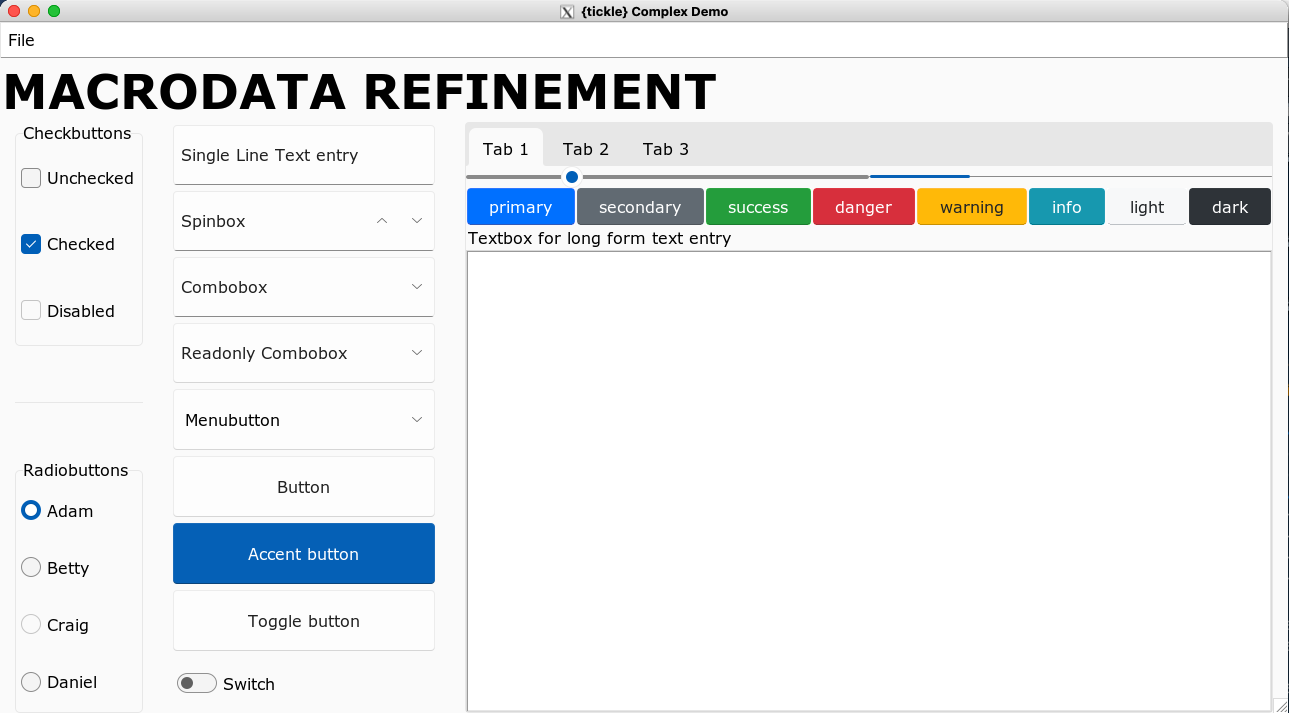tickle 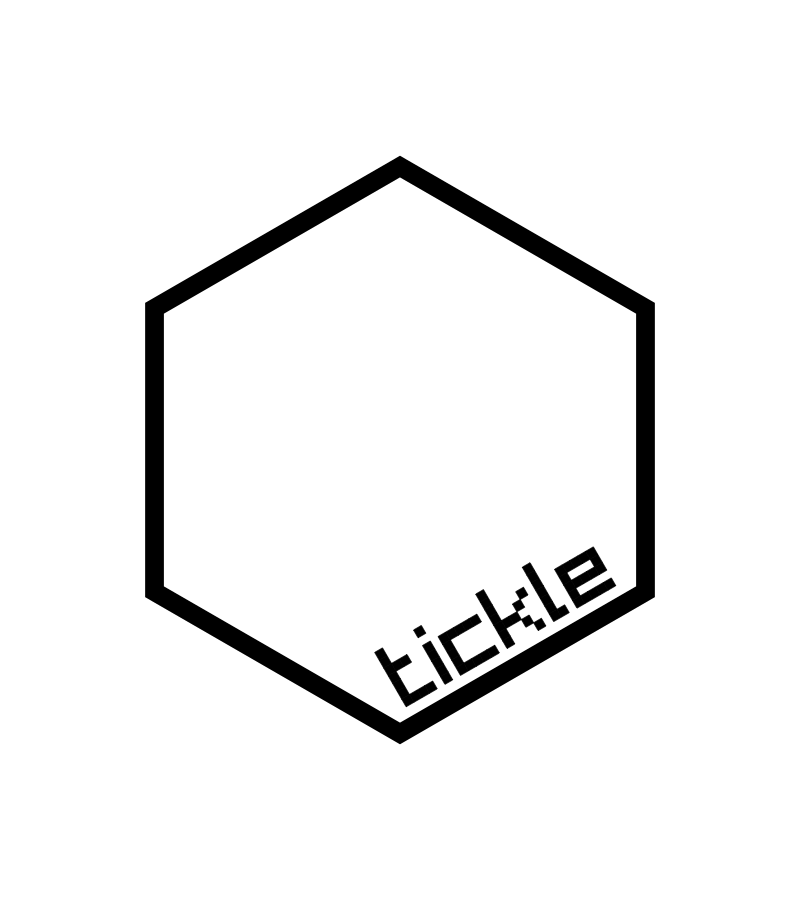
{tickle} is a package for creating UIs in base R.
This is an opinionated abstraction over the base R package {tcltk}.
This package aims to provide:
- a simplified UI creation process similar to
shiny. - a modern-looking visual default.
- more documentation to help create common UI elements without resorting to the online tcl/tk documentation.
- a way to still access the low-level tcl/tk structures in order to achieve complex effects and customisation.
What’s in the box
- An array of
tic_*()functions for nested creation of a UI specification. render_ui()to render a UI specification into a window onscreen.reactive_*()to create reactive values used to transfer values between the UI and Rcanvas_*()functions to do some simple drawing an manipulation on canvas widgets.
Overview
- Create reactive variables (with
reactive_*()) in order to pass values between R and the UI. e.g. the value of the slider, or the text in a text entry box. - Define callback functions that are called, say, when a button is pressed.
- Create a UI specification by nesting containers and widgets with
tic_*()calls. This specification can include- binding callback functions to particular events like mouse buttons or key presses (
bindargument) - controlling how widgets are packed within their parent container (
packargument)
- binding callback functions to particular events like mouse buttons or key presses (
- Render the UI to an actual object on the screen with
render_ui() - The object returned by
render_ui()can be ignored by beginners. For intermediate/advanced users, this object is a nested list oftclObjobjects representing the UI components, and these can be further manipulated with{tcltk}to finesse and configure the UI.
Installation
You can install from GitHub with:
# install.package('remotes')
remotes::install_github('coolbutuseless/tickle')Hello World
Things to note:
- Define a reactive variable for the slider before defining the UI
- UI specificaiton created with nested
tic_*()calls. - Some commands (e.g.
tic_button()) have an explicit command function which is run when they are activated. - After defining the UI specificaiton, it is rendered to screen with
render_ui()
library(tickle)
value <- reactive_dbl(40)
ui_spec <- tic_window(
title = "Hello World",
tic_row(
tic_col(
tic_button("Hello", command = function() {message("Hello")}, style = 'primary'),
tic_button("World", command = function() {message("World")})
),
tic_col(
tic_slider(value),
tic_label(textvariable = value)
)
)
)
win <- render_ui(ui_spec)
Examples/Vignettes
Please view the online vignettes for more details on how to use {tickle}
Containers
Containers are ways of grouping multiple widgets.
Containers can be nested within other containers to achieve complex layouts.
| Container | Code/Description |
|---|---|
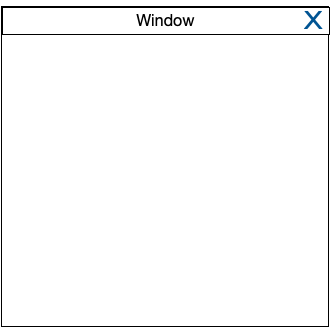 |
tic_window(…)Create a top level window |
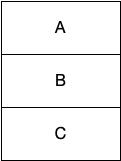 |
tic_col(A, B, C)Layout objects in column |
 |
tic_row(A, B, C)Layout objects rowwise |
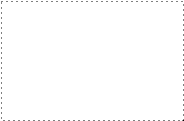 |
tic_frame(…)Invisible container. Useful for advanced users who want to customize layout |
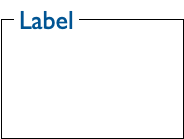 |
tic_labelframe(…)Frame with a a label and usually visible outline |
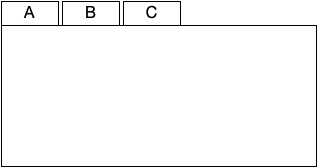 |
tic_notebook(A, B, C)Tabbed display |
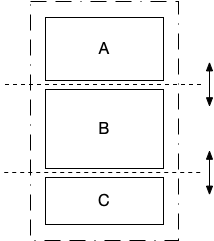 |
tic_panedwindow(A, B, C)Layout multiple elements which can be resized as panes |
Widgets
| Widget | Code/Description |
|---|---|
 |
tic_label(…)Display text. If you need headings rather than body text, Use style = 'h1' to style = 'h5' for different sized text |
 |
tic_button(…)Clickable button. Available style options: ‘primary’, ‘seconary’, ‘info’, ‘success’, ‘warning’, ‘danger’, ‘light’, ‘dark’ |
 |
tic_checkbutton(…)On/off button (default styling) |
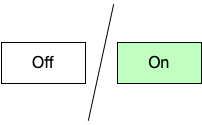 |
tic_checkbutton(…)On/off button with style = 'toggle' |
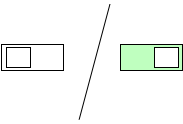 |
tic_checkbutton(…)On/off button with style = 'switch' |
 |
tic_radiobutton(…)Groups of mutually exclusion options |
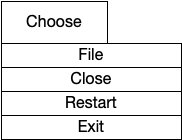 |
tic_menubutton(…)Button which displays a drop-down menu |
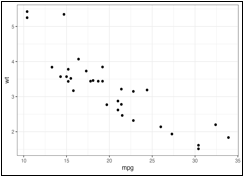 |
tic_canvas(…)General drawing canvas |
 |
tic_spinbox(…)Choose options |
 |
tic_combobox(…)Choose options |
 |
tic_textentry(…)Single line text entry |
 |
tic_textbox(…)Multipe line text entry |
 |
tic_progressbar(…)Progress bar |
 |
tic_slider(…)Slider |
Popups
Popups are windows which are initiated separate from the main UI.
| Popup | Code/Description |
|---|---|
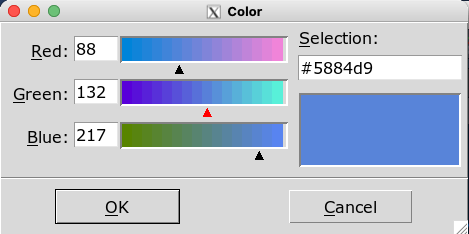 |
popup_color_picker() |
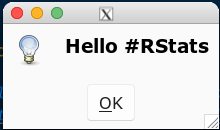 |
popup_messagebox() |
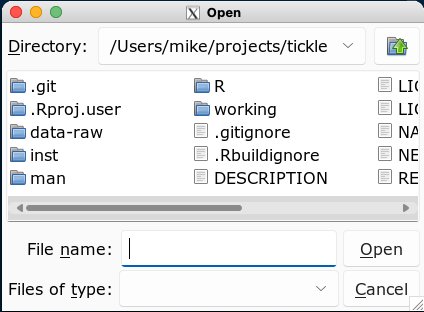 |
popup_open_file() |
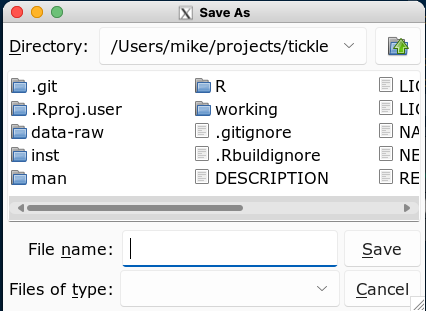 |
popup_save_file() |
Canvas
After creating a canvas with tic_canvas(), it can be manipulated with the following
commands:
- Draw on the canvas
canvas_line()canvas_text()canvas_rect()canvas_polygon()canvas_oval()canvas_arc()
canvas_plot()render a plot to the canvascanvas_clear()clear all objects from the canvascanvas_image()render an image from a file to the canvascanvas_save()save the contents of the canvas to an image file.
The actual canvas in tcl/tk renders structured graphics and it is much more like SVG or PDF than just a simple array of pixels.
The canvas implementation in this package treats the canvas as just a raster object i.e. a rectangular collection of pixels. This made it easier to write this package and keep the API/syntax simple, but it doesn’t unleash the full power of the canvas.
The effort to write a more complete abstraction over the canvas is not currently warranted. Please get in contact if such a facility is important to you.
Theme
The theme for this package is an adaptaton of the sun-valley-light
theme available from rdbende on github.
The sun-valley-light theme is MIT licensed (see “LICENSE-sun-valley”) and has been adapted
into the theme r-sun-valley-light included in this package which has the following extra features:
- Styles ‘h1’ through ‘h5’ for different sized heading text to use with
tic_label()widgets.- To use:
tic_label(..., style = 'h1')
- To use:
- Standard buttons colours from Bootstrap
to use with
tic_button()widgets.- To use:
tic_button(..., style = 'primary') - Available styles: primary, secondary, success, danger, warning, info, light, dark
- To use:
Possible Future Features
The following items are not yet implemented, or incomplete:
- Popup menus when a user right-clicks in the window.
- No access yet to the “grid” geometry layout.
- treeview, listbox and some other widgets
Package Name
tclis the scripting languagetkis the graphics toolkit fortcltcl/tkis often how the langauge and toolkit are talked about as a single entity{tcltk}is the R package interfacing totcl/tktclis often pronounced as “tickle” i.e.tcl/tk= “tickle-tee-kay”
Acknowledgements
- R Core for developing and maintaining the language.
- CRAN maintainers, for patiently shepherding packages onto CRAN and maintaining the repository

